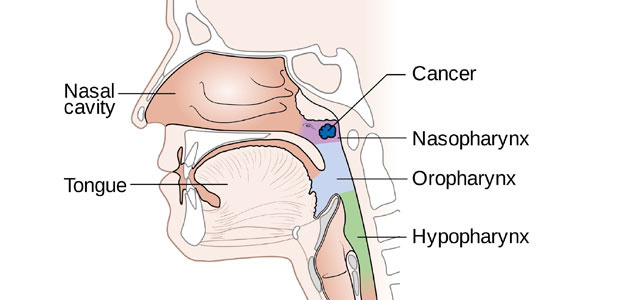
The nasopharyngeal cancer pathology report is an important basis for oncologists to formulate follow-up treatment plans. However, many nasopharyngeal cancer patients and their families are difficult to read due to the strong professionalism of pathological reports. In order to help people have a better understanding of the medical terminology in the report, we have collated some common terms in the report for preliminary interpretation.
If you want to know more about the report on nasopharyngeal cancer, you can make an appointment online or contact our Manila office at 02-8-822122 or Cebu office 0917-599-2277, professional oncologists will help to answer your questions.
1. The position of nasopharynx
The nasopharynx is the upper part of the throat behind the nose, which lies just above the soft part of the root of the mouth and just in back of the nasal passages. It is a part of the pharynx, which comprises three separate segments: the nasopharynx, oropharynx, and the hypopharynx.
Nasopharynx is one of the organ that has a lot of lymphoid tissue, the cancer cells may spread to the lymph glands on one or both sides of the neck.
2. Classification of nasopharyngeal cancer: (keratinizing squamous cell carcinoma, non-keratinizing cell carcinoma and undifferentiated carcinoma)
World Health Organization (WHO) had divide nasopharyngeal cancer into three categories:
Type 1 : keratinizing squamous cell carcinoma (well differentiated)
Type 2 : non-keratinizing squamous cell carcinoma
Type 3 : undifferentiated carcinoma.
NPC is much more common in Southeast Asia, nearly all cases are the non-keratinizing squamous cell carcinoma.
3. What is Non-keratinizing squamous cell carcinoma?
Non-keratinizing is referred to the differentiated of squamous cell carcinoma, it can be classified as moderate differentiation. Differentiation is the grade of cancer, poorly differentiated cancers tend to grow and spread faster. Squamous cell carcinoma, the second most common form of skin cancer, is an uncontrolled growth of abnormal cells arising from the squamous cells in the epidermis, the skin’s outermost layer. This type of malignant cancer is growing faster and may damage eye tissue; it also will spread to submandibular lymph nodes or may spread to distant organ.
4. Tumor marker of nasopharyngeal cancer —— Epstein-Barr Virus (EBV)
In most cases of nasopharyngeal cancer, high level of Epstein-Barr Virus (EBV) antibodies are found in patients’ serum. Test of EBV antibody is an common method of nasopharyngeal cancer diagnosis. Patient with high level of EBV antibody is required to take further examination to figure out whether he/she has nasopharyngeal cancer or not.
If you want to know more about the report on nasopharyngeal cancer, you can make an appointment online or contact our Manila office at 02-8-822122 or Cebu office 0917-599-2277, professional oncologists will help to answer your questions.
Tips from oncologist at St. Stamford Modern Cancer Hospital Guangzhou: The above is only a partial interpretation of the pathology report of nasopharyngeal cancer. Please find a qualified oncologist for a comprehensive interpretation on a detailed pathology report, so that patients can receive guidance and treatment on time to avoid irreversible consequences.
 viber
viber